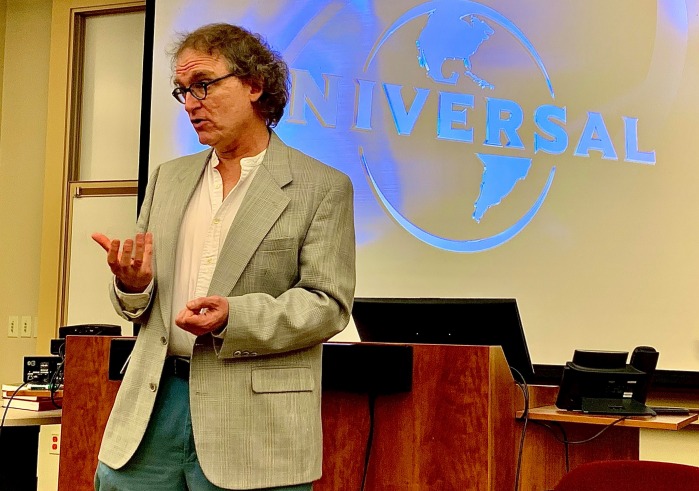What Makes a Movie? A Vertiginous Trip through Hitchcock and Hollywood

Oleg Gelikman, professor and director of the Humanities concentration, introduced visiting professor O. Bradley Bassler’s lecture on Hitchcock’s Vertigo with intrigue, referring to the classic as “something that is clearly not a film.”
Many students—both from and outside of John Kehlen and Jim Merod’s Film History and Cinematic Technique course—attended the event and came away with a deeper appreciation for Hitchcock and his methods.
O. Bradley Bassler, associate professor of philosophy and its relation to literature, mathematics, and physics at the University of Georgia, called Vertigo “a movie which one has to see and engage over a long period of time.” He marveled at “the extent to which Vertigo continues to open itself up” and how it addresses “the way our experiences drift off into the past and rise up from the past.”
Bassler used Vertigo and Dave Thomson’s The Whole Equation: A History of Hollywood to answer three essential questions of cinema: What makes a movie? What makes a good movie? What does a movie do to us? Bassler claimed that a successful film must be entertaining and have aesthetic effect; if it’s entertaining but lacks aesthetic effect it’s a cheap thrill, and if it has aesthetic effect but doesn’t entertain it’s an arthouse film. With its gripping plot twist and enrapturing visual metaphors, Vertigo satisfies the whole equation.
Bassler explained that Hitchcock pioneered the art of storyboarding and “mapped out movies in such detail that he could direct the film over the phone.” Hitchcock’s methodical and intentional directing allowed Vertigo to explore metaphysical themes like the uneasy differentiation of dreams and reality. Bassler evinced Vertigo’s subtle genius by playing a scene that begins with Johnny (the main character) waking up, and then asked the audience “was the preceding scene just a dream?”
When asked what to look for in a film as markers of quality and timelessness, Bassler responded “There are certain movies, and often it will be the case that you can’t consciously see why this happens, that manage to capture the spirit of something. You can feel it, and you can tell because you almost feel like you’re there. You’re a part of it. What is required is a certain kind of identification with the movie, and yet, of course, that identification shouldn’t be something in which you totally lose yourself. It requires this complicated condition in which you continue to recognize at some level, even at just the back of your head, that you’re watching a movie and that you’ve become absorbed in your watching.”
Bassler, like Hitchcock, gave the audience a thrilling vertigo with his professional and creative exploration of our storied relationship with cinema.
—Riley Murphy ‘20
